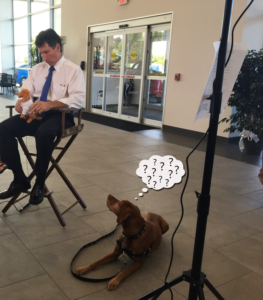Your next Fido just might be a robot.
The benefits for grandma
An aging population
How kids respond to robotic Rover
See the latest news and share your comments with CNN Health on Facebook and Twitter.
Your next Fido just might be a robot.
See the latest news and share your comments with CNN Health on Facebook and Twitter.

We suppose it makes sense that, after humans, connected dogs are the next big thing. Link AKC, backed by the American Kennel Club (hence the AKC), has just announced a smart collar designed to give dog owners more information about their pooch’s well being.
The collar does a few different things, from tracking your dogs’s location to monitoring its comfort. The collar’s built-in GPS means you’ll be able to keep an eye on your pup’s location at all time, and, when paired with the base station, even set up a “virtual fence” that will alert you if the dog starts wandering astray. There’s also a handy remote-controlled light in case you need to go out at some ungodly hour in search of your canine companion.
Like any wearable worth its salt, the collar also functions as an activity tracker- Fitbit et al, if you’re reading this, there’s a market you’re overlooking here. The Link AKC collar will let owners track their dogs’ activity levels and see whether it’s getting the right amount of exercise each day, taking into account its breed, age and size.
One of the best features, we think, is the temperature sensor that will alert you if your dog is in an environment that’s too hot or cold. Considering the number of foolish people who still leave dogs in hot cars despite all common sense and endless public service announcements (seriously, just don’t do it, yeah?), this could potentially save some lives.

Finally, the collar has a feature called ‘Adventures’ that will let you create a “scrapbook” of memories with your dog by pushing a button, which you can then share on social media. We assume this will be more like a Facebook check-in with a photo, and that it won’t be uploading a montage of you and your dog frolicking in the forest to Starship’s ‘Nothing’s Gonna Stop Us Now’ – but we secretly hope for the latter.
A lot of emphasis is being put on how the collar looks too, and we can see why; somehow the market for wearable dog tech has already nailed fashion better than the human one.
The collar will cost $199, however you’ll also need to sign up for a monthly membership in order to use the device, and plans start at $6.95 with a two-year commitment. We reckon that might put some people off.
The collar will be shipping by December 28, the company says, however right now it can only be ordered to the US. You can reserve one today from the website, and we’ll let you know if we get word on UK pricing and availability.
It’s been said there’s an app for anything we humans want.
Now there’s an app for man’s best friend. More than a few of them, actually.
Dog owners today can book their pups a sitter, find personal walkers, and set up doggie play dates, all with a few taps on their phones.
As the number of pets in this country has increased, so too has the demand for related services.
“In the last couple of years, the [pet] app world has exploded,” said Leslie May, founder of Pawsible Marketing, a marketing firm that specializes in pet businesses.
The American Pet Products Association reported that 65 percent of US households owned a pet between 2015 and 2016, up from 56 percent in 1988. And Americans are spending more on their pets. The association estimates that owners will spend $2.47 billion more on their pets this year than in 2015.
Those numbers have made the pet industry an appealing one for the startup world.
“It was a natural move for technology companies to look at the pet market as an opportunity,” May said. “It’s a growing industry; it’s been growing steadily for years.”
Aaron Easterly started his Seattle-based dog services company, Rover, in 2011 as an overnight pet-sitting business that was marketed as a better option than the kennel. It later added doggy day care, drop-in visits, and daily dog-walking services for busy dog “parents.’’ The company now boasts a network of 40,000 dog owners and sitters in Boston alone, with owners able to access the service through its website and mobile app.
“There’s this desire to be as good of a parent as possible to your pet or your dog,” Easterly said. “And that increases the demand for products that can help you be a better pet parent.”
But to best serve pet parents, you don’t just need to know technology, you need to know what they want, said Michelle Fournier, the founder of Durty Harry’s, a popular boutique and dog wash business in Charlestown and Brookline.
Fournier never imagined leaving the company that she had built. But when her customers would not stop asking if she knew of dog-friendly hotels, restaurants, and parks where they could bring their pups, she saw the need for a service in 2013 that did not yet exist. So she closed her boutiques in 2015 and went into the pet tech industry.
Last month, she launched an app called Slobbr that gives users the same advice she used to dole out for free in her shops: where to find pet-friendly establishments. Slobbr raised $65,000 on Kickstarter. As she continues to build the business, Fournier saids she believes what will set some pet companies apart is a keen understanding of the client — in her case, dogs.
“I look at the folks who put out pet apps. They have great tech experience, but they don’t have dog knowledge. You have to be able to understand what pet owners are looking for,” she said. “And when you’re not in that space, you can be the smartest business person in the world, but you’ll miss your mark.”
The American Pet Products Association estimates that the pet industry now tops $63 billion and there are no signs of slowing. The more people continue to cater to their dogs and cats, the more they are demanding streamlined technology that puts more services in one place. And the pet tech world is responding.
“Apps are [now] more sophisticated, making things easier for the pet parent,” said May.
The key, of course, is predicting what pet owners will want next from technology.
“It’s critical to latch on now for the next big wave,” she said.

My Dad and I were live on television yesterday. This is me getting into character.
The moment Poncho the chihuahua saw the apartment under the stairs, he knew this would be his bachelor pad. “You gotta see this place,” he bragged to his friends. “It’s prime real estate. Sure, it’s a studio, but you know what they say when it comes to house hunting: location, location, location!” The housing market had been totally insane these past few years, so he knew he lucked out when he finally found a place he could afford on his modest dog salary of $0.
He became fast friends with his roommate and landlord, Betty McCall of Pitts, Georgia. The sweet lady even went so far as to decorate his digs for him, with little touches like a sombrero hanging from decorative antlers on the wall, and an oil painting that reminded him of his brothers back home.
/cdn0.vox-cdn.com/uploads/chorus_asset/file/7067837/poncho2.0.jpg) Will Rigdon
Will RigdonShe was respectful of his space, too. Poncho had a strong, tall door, so he could enjoy his privacy when felt the urge to noodle on the piano or think about the heavier stuff. McCall told him not to croon after midnight, but whatever. His room, his rules.
/cdn0.vox-cdn.com/uploads/chorus_asset/file/7067885/poncho3.0.jpg) Will Rigdon
Will RigdonStill, he didn’t want to be too disrespectful. After all, she did get a carpenter to install an outlet in his room so he could have an electric blanket in there for the lonely winters. She was good to him. And the place — well, even he could admit, when his friends weren’t in earshot, that it wasn’t much. But at least it was his.

Who do you predict to win tonight?